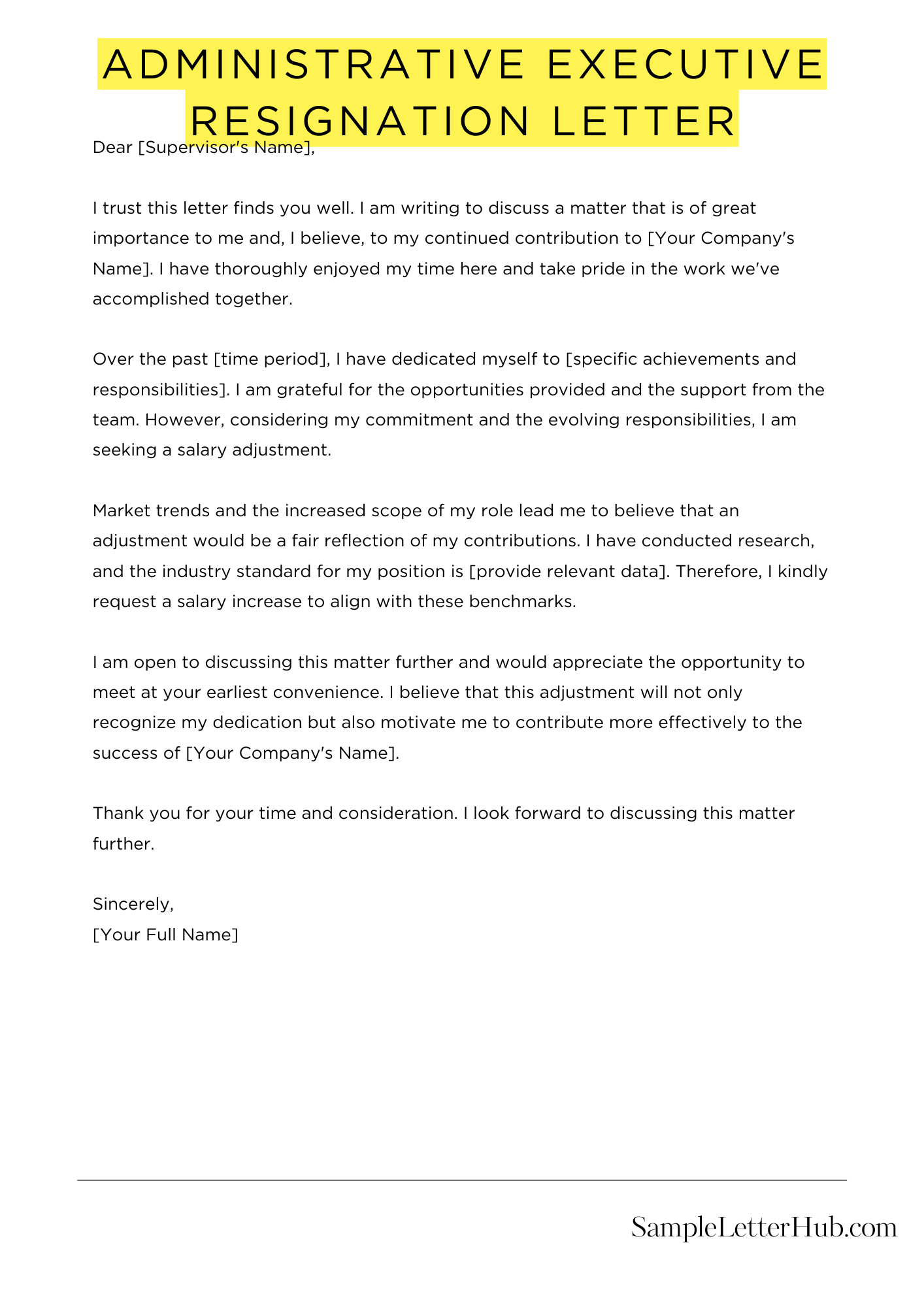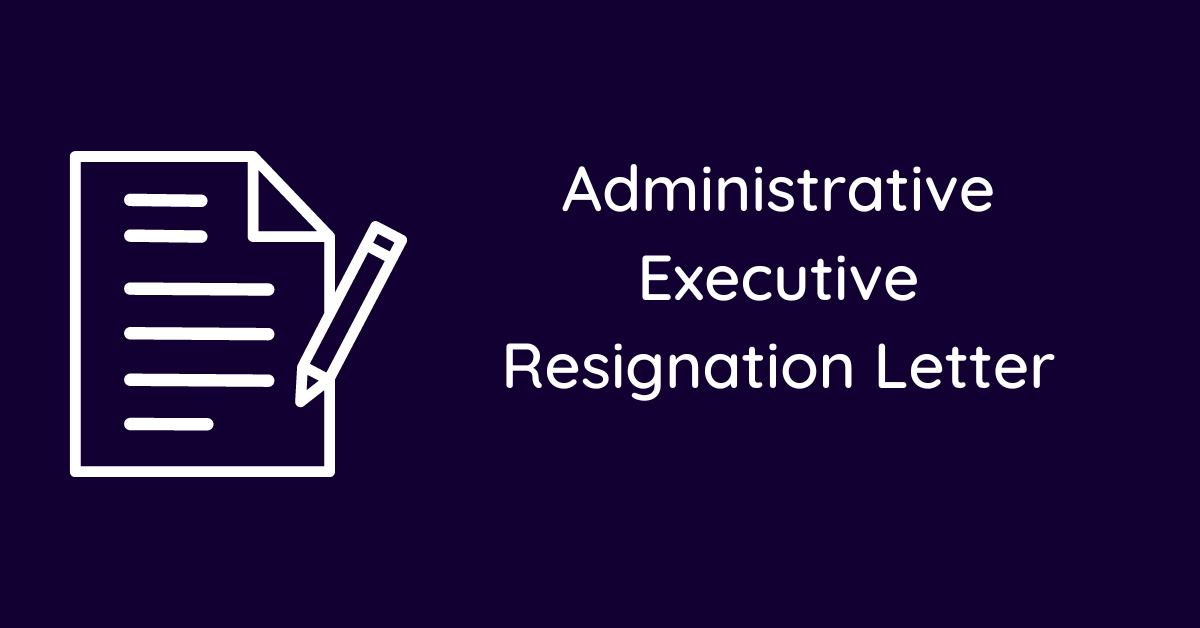When it comes to leaving a job, an administrative executive resignation letter is a crucial tool to communicate your decision to your employer. It’s a formal document that outlines your reasons for leaving and expresses your gratitude for the opportunity to work in the company. In this article, we’ll provide you with an example of an administrative executive resignation letter that you can use as a template for your own.
Remember, a resignation letter should be clear, professional, and polite. It’s not just about informing your employer of your decision; it’s also an opportunity to leave a positive impression. Be humble and express your appreciation for the experience and support you’ve received during your time with the company.
Below, we’ve included a sample administrative executive resignation letter that you can use as a reference. Feel free to tailor it to your specific situation and add any additional details that you feel are relevant.
Administrative Executive Resignation Letter
Dear [Recipient Name],
Please accept this letter as formal notification that I will be resigning from my position as Administrative Executive at [Company Name], effective [Last Date of Employment].
During my tenure, I have valued the opportunities and experiences I have gained. I am grateful for the support and guidance I have received from you and my colleagues.
I wish you and [Company Name] all the best in the future.
Sincerely,
[Your Signature]
Short Administrative Executive Resignation Letter Sample
Please accept this letter as formal notification that I am resigning from my position as Administrative Executive at [Company Name]. My last day of employment will be [Your Last Day]. Thank you for the opportunity to grow and learn during my time here. I wish you and the company continued success. I am happy to assist in the transition process to ensure a smooth handover of my responsibilities.
I wish you all the best with your administrative executive resignation letter.
When it’s time to say farewell, expressing your gratitude and best wishes can make the transition smoother:

How to Write an Administrative Executive Resignation Letter
1. Start with a Professional Salutation
Begin your letter with a formal salutation, such as “Dear [Manager’s Name].”
2. State Your Intention to Resign
Clearly state your intention to resign from your position as an Administrative Executive. Include the date your resignation will take effect.
3. Express Gratitude
Express your gratitude for the opportunity to work at the company. Mention specific experiences or accomplishments that you are thankful for.
4. Offer to Help with the Transition
Offer to assist in any way possible to make the transition smooth. This could include training your replacement or completing any outstanding projects.
5. Close with a Professional Tone
End your letter with a professional closing, such as “Sincerely,” followed by your typed name.
6 Most Frequently Asked Questions About Administrative Executive Resignation Letters
Resigning from a position as an administrative executive can be a daunting task. To help you navigate the complexities of writing a resignation letter, we’ve compiled a list of the six most frequently asked questions and their answers.
1. What is the proper format for an administrative executive resignation letter?
An administrative executive resignation letter should follow a formal business letter format. It should include your name, address, date, the recipient’s name, their title, and the company name. The body of the letter should include a clear statement of your resignation, your last date of employment, and a brief expression of gratitude for the opportunity to work at the company.
2. How much notice should I give?
The amount of notice you should give depends on your company’s policies and the terms of your employment contract. However, it is generally considered good practice to give at least two weeks’ notice. This will give your employer time to find a replacement and ensure a smooth transition.
3. What should I include in my resignation letter?
In addition to the basic information mentioned above, you may also want to include a brief statement of your reasons for resigning. This is not required, but it can be helpful to provide your employer with some context for your decision.
4. How can I make my resignation letter stand out?
There are a few things you can do to make your resignation letter stand out from the crowd. First, take the time to proofread your letter carefully for any errors. Second, use a professional font and layout. Finally, consider adding a personal touch, such as a handwritten note or a brief anecdote about your time at the company.
5. What should I do if I’m not sure how to write a resignation letter?
If you’re not sure how to write a resignation letter, there are a number of resources available to help you. You can find templates and examples online, or you can consult with a career counselor or human resources professional.
6. What are some common mistakes to avoid when writing a resignation letter?
Some common mistakes to avoid when writing a resignation letter include:
* Being negative or critical of your employer
* Giving too much personal information
* Resigning effective immediately without giving proper notice
* Not proofreading your letter for errors
Before making the decision to resign from your job, it’s essential to consider the legal aspects:
Understanding your emotions after quitting your job is important. Explore why you might be feeling sad:
Related
- Resignation letter sample
- Forced resignation letter
- Resignation letter due to going abroad
- Resignation letter due to marriage
- Resignation letter due to other opportunity
- Resignation letter due to mistake

